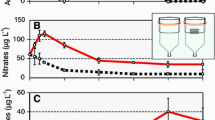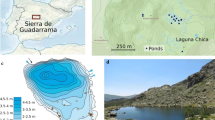Abstract
Among the 19 non-native species of marine invertebrates which have invaded the Venice Lagoon and have established populations, Ruditapes philippinarum, deliberately introduced in 1983, is surely the most successful species. According to the hypothesis that alien species invasion could be favoured by an altered ecological, chemical or physical state of the system induced by anthropogenic disturbance, R. philippinarum turned out to be ‘the right species at the right moment’. By comparing historical data (1968, 1985, 1990) with 1999 data, changes in macrobenthic community, in particular bivalve molluscs, of the lagoon induced by R. philippinarum introduction and subsequent clam exploiting activity were assessed. It has been possible to describe a sharp reduction, both in terms of distribution area and density, of all other filter feeder bivalves. Moreover, by using the clearance rate of the most abundant bivalve species in 1990 and 1999 (Cerastoderma glaucum and R. philippinarum, respectively), it was possible to estimate that the filtration capacity, expressed as l h−1 m−2, has more than doubled. This has altered the functioning of the ecosystem, resulting in a stronger benthic–pelagic coupling. In this context, R. philippinarum attains control of the system. Considering all this, it is possible to state that the Venice Lagoon ecosystem has entered into a new state, probably more resistant but less resilient, with implications for future management choices.
Similar content being viewed by others
References
JD Ackerman, MR Loewen and PF Hamblin, Benthic-pelagic coupling over a zebra mussels reef in western lake Erie. Limnology and Oceanography 46 (2001) 892-904
M Bartoli, D Nizzoli, P Viaroli, E Turolla, G Castaldelli, EA Fano and R Rossi, Impact of Tapes philippinarum farming on nutrient dynamics and benthic respiration in the Sacca of Goro. Hydrobiologia 45 (2001) 203-212
JE Byers, Impact of non-indigenous species on natives enhanced by anthropogenic alteration of selection regimes. Oikos 97 (2002) 449-458
JE Byers, S Reichard, JM Randall, IM Parker, CS Smith, WM Lonsdale, IAE Atkinson, TR Seatedt, M Williamson, E Chornesky and D Hayes, Directing research to reduce the impacts of non-indigenous species. Conservation Biology 3 (2002) 630-640
JT Carlton, Pattern, process and prediction in marine invasion ecology. Biological Conservation 78 (1996) 97-106
JT Carlton and JB Geller, Ecological roulette: the global transport of non-indigenous marine organisms. Science 261 (1993) 78-82
A Carrieri, F Paesanti and R Rossi, Risultati dell’introduzione della vongola filippina Ruditapes philippinarum (Adams & Reeve, 1850) nella sacca di Goro (delta del Po). Oebalia 9 (1992) 675-680
P Cesari, I Molluschi della Laguna Veneta. Venezia: Arsenale editrice (1994).
P Cesari and M Pellizzato, Molluschi pervenuti in Laguna di Venezia per apporti volontari o casuali Acclimatazione di Saccostera commercialis (Iredale and Roughely, 1933) e di Ruditapes philippinarum (Adams & Reeve, 1850). Bollettino Malacologico 21 (1985) 237-274
JE Cloern, Our evolving conceptual model of the coastal eutrophication problem. Marine Ecology Progress Series 210 (2001) 223-253
D Curiel, G Bellemo and M Marzocchi, New records of marine algae in the Lagoon of Venice. Giornale Botanico Italiano 130 (1996) 352
D Curiel, G Bellemo, B Rocca La, M Scattolin and M Marzocchi, First report of Polysiphonia morrowii Harvey (Ceramiales, Rhodophyta) in the Mediterranean sea. Botanica. Marina 45 (2002) 66-70
P Cury, A Bakun, RJM Crawford, A Jarre, RA Quiñones, LJ Shannon and HM Verheye, Small pelagics in upwelling systems: patterns of interaction and structural changes in “wasp-waist” ecosystems. ICES Journal of Marine Science 57 (2000) 603-618
JS Dukes, Biodiversity and invasibility in grassland microcosms. Oecologia 125 (2001) 563-568
Elton C (1958) The Ecology of Invasions by Animals and Plants. University Chicago Press, 181 pp
F Ghisotti, Rivenimenti malacologici nel Mediterraneo. Conchiglie 10 (1972) 20-21
A Giordani Soika and G Perin, L’inquinamento della Laguna di Venezia: studio delle modificazioni chimiche e del popolamento sottobasale dei sedimenti lagunari negli ultimi vent’anni. Bollettino del Museo Civico di Venezia 26 (1974) 25-68
I Ibarrola, E Navarro and JIP Iglesias, Short-term adaptation of digestive processes in the cockle Cerastoderma edule exposed to different food quantity and quality. Journal of Comparative Physiology B 168 (1998) 32-40
Leppäkoski E. (1993) Nonindigenous Estuarine and Marine Organism. National Oceanic and Atmospheric Administration, Washington, DC. pp 37–44.
S Libralato, F Pranovi, P Torricelli, S Raicevich, F Ponte Da, R Pastres and D Mainardi, Ecological stages of the Venice Lagoon analysed using landing time series data. Journal of Marine Systems 51 (2004) 331-344
MAV-CVN (1992) Studio A3.16/II Composizione delle comunità biologiche connesse con le modifiche morfologiche - II fase, 123 pp
L Mizzan, Le specie alloctone del macrozoobenthos della laguna di Venezia: il punto della situazione. Bollettino del Museo civico di Storia Naturale di Venezia 49 (1999) 145-177
HA Mooney and RJ Hobbs, Invasive Species in a Changing World. Washington DC: Island Press (2000).
S Naeem, JMH Knops and D Tilman, Plants diversity increases resistance to invasion in the absence of covarying extrinsic factors. Oikos 91 (2000) 97-108
RL Naylor, S Williams and DR Strong, Aquaculture – a gateway for exotic species. Science 294 (2001) 1655-1656
RIE Newell, JC Cornwell and MS Owens, Influence of simulated bivalve biodeposition and microphytobenthos on sediment nitrogen dynamics: a laboratory study. Limnology and Oceanography 47 (2002) 1367-1379
A Occhipinti Ambrogi, Current status of aquatic introductions in Italy. In: E Leppäkoski, S Gollash and S Olenin (eds.) Invasive Aquatic Species of Europe: Distributions, Impacts and Management. Dordrecht The Netherlands: Kluwer Academic Publisher (2002) pp. 311-342
IM Parker, D Simberloff, WM Lonsdale, K Goodell, M Wonham, PM Kareiva, MH Williamnson, B Holle Von, PB Moyle, JE Byers and L Goldwasser, Impact: toward a framework for understanding the ecological effects of invaders. Biological Invasions 1 (1999) 3-19
R Pastres, C Solidoro, S Ciavatta, A Petrizzo and G Cossarini, Long-term changes of inorganic nutrients in the Lagoon of Venice (Italy). Journal of Marine Systems 51 (2004) 179-189
F Pranovi, S Libralato, S Raicevich, A Granzotto, R Pastres and O Giovanardi, Mechanical clam dredging in Venice Lagoon: effects on ecosystem stability evaluated with a trophic mass-balance model. Marine Biology 143 (2003) 393-403
F Pranovi, F Ponte Da, S Raicevich and O Giovanardi, A synoptic-multidisciplinary study of the immediate effects of mechanical clam-harvesting in the Venice Lagoon. ICES Journal of Marine Science 61 (2004) 43-52
Piano per la gestione delle risorse alieutiche delle lagune della provincia di Venezia. Venezia: Provincia di Venezia (2000).
A Ricciardi, FG Whoriskey and JB Rasmussen, The role of zebra mussels (Dreissena polymorpha) in structuring macroinvertebrate communities an hard substrata. Canadian Journal of Fisheries and Aquatic Sciences 54 (1997) 2596-2609
E Rinaldi, Osservazioni relative a molluschi appartenenti al genere Anadara viventi in Adriatico. Conchiglie 8 (1972) 121-124
GM Ruiz, ED Carlton, ED Grosholz and AH Hines, Global invasions of marine and estuarine habitat by non-indigenous species: mechanism, extent, and consequence. American Zoologist 37 (1997) 950-632
GM Ruiz, P Fofonoff, AH Hines and AH Groshols, Non-indigenous species as stressor in estuarine and marine communities. Assessing invasion impacts and interactions. Limnology and Oceanography 44 (1999) 950-972
GM Ruiz, P Fofonoff, JT Carlton, MJ Wonham and AH Hines, Invasion of coastal marine communities in North America: apparent patterns, processes and biases. Annual Review of Ecology and Systematics 31 (2000) 481-531
A Sfriso, C Facca and PF Ghetti, Temporal and spatial changes of macroalgae and phytoplankton in a Mediterranean coastal area: the Venice Lagoon as case study. Marine Environmental Research 56 (2003) 316-636
LJ Shannon, PM Cury and A Jarre, Modelling effects of fishing in the Southern Benguela ecosystem. ICES Journal of Marine Science 57 (2000) 720-722
OE Sala, FS Chapin III, JJ Armesto, E Berlow, J Bloomfield, R Dirzo, E Huber-Sanwald, LF Huenneke, RB Jackson, M Walker and DH Wall, Global biodiversity scenarios for the year 2100. Science 287 (2000) 1770-1774
YI Sorokin and O Giovanardi, Trophic characteristics of the Manila clam (Ruditapes philippinarum Adams & Reeve,1850). ICES Journal of Marine Science 52 (1995) 835-862
I Sorokin, O Giovanardi, F Pranovi and P Sorokin, Need for restricting bivalve culture in the southern basin of the Lagoon of Venice. Hydrobiologia 400 (1999) 141-148
DL Strayer, Effects of alien species on freshwater molluscs in North America. Journal of the North American Benthological Society 18 (1999) 74-98
AY Troumbis, A Galanidis and GD Kokkoris, Components of short-term invasibility in experimental Mediterranean grasslands. Oikos 98 (2002) 239-250
GJ Vermeij, An agenda for invasion biology. Biological Conservation 78 (1996) 3-9
PM Vitousek, HA Mooney, J Lubchenco and JM Melillo, Human domination of Earth’s ecosystems. Science 277 (1997) 494-499
J Widdows and MD Brinsley, Impact of biotic and abiotic processes on sediment dynamics and the consequences to the structure and functioning of the intertidal zone. Journal of Sea Research 48 (2002) 143-156
MJ Wonham and JT Carlton, Trends in marine biological invasions at local and regional scales: the Northeast Pacific Ocean as a model system. Biological Invasion 7 (2005) 369-392
Zentilin A (1990) Venericoltura in laguna di Marano. In: Ruditapes philippinarum, biologia e sperimentazione. Ente Sviluppo Agricolo del Veneto 201–205
Author information
Authors and Affiliations
Corresponding author
Rights and permissions
About this article
Cite this article
Pranovi, F., Franceschini, G., Casale, M. et al. An Ecological Imbalance Induced by a Non-Native Species: The Manila Clam in the Venice Lagoon. Biol Invasions 8, 595–609 (2006). https://doi.org/10.1007/s10530-005-1602-5
Received:
Accepted:
Published:
Issue Date:
DOI: https://doi.org/10.1007/s10530-005-1602-5




